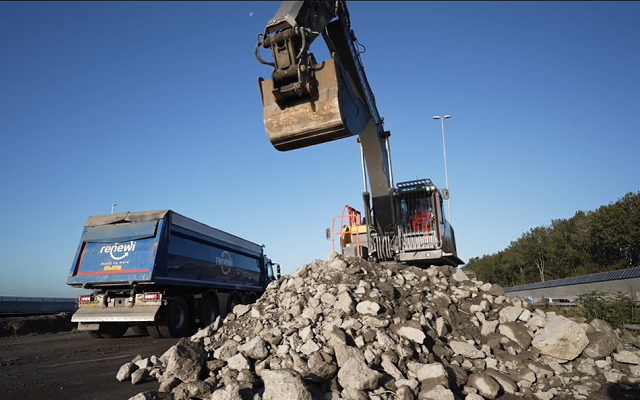Concrete recycling helps close the loop: Rijkswaterstaat, VeenIX and Renewi work together to widen the A9 sustainably
09 January 2025

Working together to build a circular future for Dutch infrastructure
On behalf of Rijkswaterstaat, consortium Veenix, with FCC as main contractor, is widening and deepening the A9 between the Badhoevedorp and Holendrecht interchanges. Waste-to-product company Renewi recycles 40,000 tonnes of concrete rubble released from the demolition of two viaducts. This material can be put back into use in Rijkswaterstaat construction projects as a raw material for concrete.
Urgency of concrete recycling grows
The construction industry faces a major challenge due to the decreasing availability of natural raw materials. By 2030, a 24% decline in sand mining and 44% in gravel mining is predicted to prevent soil erosion, among other things. As concrete consists mainly of sand and gravel, this shortage reinforces the urgency of using recycled concrete. At the same time, the amount of available concrete rubble is sharply increasing due to the demolition of post-war buildings and the growing demand for smart concrete rubble separation. By 2030, 15 million tonnes of concrete rubble is expected to be used for new concrete. According to the Concrete Accord, a nationwide initiative to make the concrete supply chain more sustainable, all concrete waste streams should be fully circular by 2030. The new guidelines also limit the use of recycled concrete in road foundations to a maximum of 5% by 2030. This encourages the repurposing of concrete debris into high-value applications, such as the production of new concrete.
High-value application thanks to advanced recycling process
Now, only a small proportion of concrete rubble is reused in new concrete. The technical complexity of the demolition and recycling process calls for a different chain approach. Concrete consists of a mix of cement, water, gravel and sand. To recycle this material, it is necessary to separate these components. Renewi developed an advanced recycling process that produces certified concrete granulate and concrete sand. These materials meet the highest quality requirements and enable more circular concrete solutions.
Thanks to this technology, concrete rubble can be reused in new concrete rather than in lower-grade applications, such as foundation material. This significantly reduces the use of primary raw materials such as gravel, sand and cement, helping to achieve higher-quality and more sustainable construction solutions.

Building a circular future together
According to CBS, the construction sector is responsible for around 25% of all waste in the Netherlands, the vast majority of which is concrete waste. Therefore, closing the concrete chain is crucial.
Jan-Pedro Vis, Director of Material Management & Outbound Sales at Renewi said: ‘Concrete is one of the most widely used building materials in the world and responsible for a lot of CO₂ emissions. Making concrete more circular is therefore essential, and that is only possible through collaboration in the chain. Lek Sloopwerken demolishes the viaducts, after which Renewi processes the concrete rubble into high-quality circular raw materials for Rijkswaterstaat construction projects. The A9 cooperation is a powerful example and marks an important step in the circular economy. But there is still a long way to go.’
Benny Nieswaag, projectmanager at Rijkswaterstaat added: ‘Reusing concrete contributes to Rijkswaterstaat's renewal task and accelerates the transition to a circular economy.’
An inspiring example towards circular infrastructure
The demolition of two viaducts along the A9, between Holendrecht interchange and Badhoevedorp, produces 40,000 tonnes of concrete debris. Renewi processes this rubble into high-quality material that can be reused in concrete for Rijkswaterstaat projects.
In addition, Renewi supplies 130,000 tonnes of recycled mixed granulate from mixed rubble. The mixed granulate can be used for the foundation of new roads.
This project is a concrete example of how circular principles can be applied in large-scale infrastructure projects. It not only offers a more sustainable solution for concrete waste, but also underlines how innovative processes and shared responsibility can accelerate the transition to a circular economy. In doing so, the A9 is an important milestone and inspiration for future projects in the Netherlands, establishing itself as a frontrunner in making the infrastructure sector more sustainable.